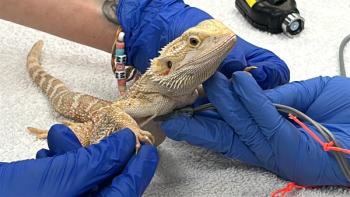
Advanced fish medicine (Proceedings)
The purpose of this presentation is to describe some basic and advanced clinical techniques that can be used by the practitioner to establish a diagnosis. Basic techniques start from simple observation of behavior and other hands-off procedures, to collection of samples such as fin and gill clips and phlebotomy.
Objectives of the Presentation
The purpose of this presentation is to describe some basic and advanced clinical techniques that can be used by the practitioner to establish a diagnosis. Basic techniques start from simple observation of behavior and other hands-off procedures, to collection of samples such as fin and gill clips and phlebotomy. Advanced techniques include imaging techniques such as radiographs, ultrasound exams, and invasive sampling techniques such as biopsies and surgical procedures.
Key Points
• Observation and environmental data collection
• Handling of the fish patient including phlebotomy
• Diagnostic procedures including imaging and biopsies
Overview of the Issue
"Non-Hands-On" Procedures
Just as body temperature, heart and respiratory rates are some of the most important data collected during the clinical exam in mammals, establishing water chemistry values and making simple observations of the fish in the water are of paramount importance when assessing the fish patient. Observations will frequently reveal abnormalities. Some frequently observed abnormal morphological features in the fish patient include exophthalmus (pop-eye), fin necrosis (fin rot), bloody fins, dermal ulcers, excessive slime layer, and cataracts. Unfortunately, while all of these signs are significant abnormal findings, they are also very non-specific. Each of these clinical signs can be caused by a multitude of different infectious and non-infectious causes. In order to correctly diagnose a possible cause, 'hands-on' procedures are required.
"Hands-On" Procedures
Skin smear
If an excessive amount of slime is noticed on the fish, and the water chemistry results are well within normal values, it is advisable to examine some of the slime under the microscope for the presence of ectoparasites. This skin smear examination can also be part of a routine health exam in order to pick up sub-clinical levels of parasites. A good sample of the slime layer can be collected by swiping a cover slip over the scales in a cranial-caudal direction with a 30-45 degree angle in the direction of the movement. The coverslip should be placed on the slide and read immediately since many ectoparasites will eventually die or stop moving, making their detection more difficult.
Fin clip
If mild or severe lesions of the fins are observed, a fin clip may reveal the causative problem. A fin clip can be done in the awake patient and will usually not need hemostasis. With a very small pair of scissors, a small sample of the tip of a fin (dorsal, anal, or caudal fin) is clipped and evaluated under the microscope. A cover slip can be used. Sometimes a drop of saline needs to be applied to the slide in order to remove air bubbles from under the cover slip.
Gill clip
In a case of respiratory distress, when lesions involving the gills are observed, or even as part of a routine health check, a gill clip can be performed. In order to avoid traumatic injuries to the patient, it is advisable to perform a gill clip under general anesthesia. A small sample of the gills can easily be collected from one of the gill arches, and again, hemostasis is usually not required if the procedure is done in a controlled fashion. A gill arch can be lifted up from the rest of the collapsed gills and the sample taken with one clip. The sample is then placed on a slide, immersed in 1-2 drops of water from the tank or saline, and then covered by a cover slip and carefully crushed. The microstucture of the gill can be observed for chronic or acute changes (e.g., excess slime layer, parasitic damage, necrosis etc.).
Phlebotomy
While we still lack significant data regarding the blood values and hemodynamics in fish, more and more data is being published in this specialty. Even without reference values blood collection can be useful in the clinical work up. The easiest way to obtain blood from a fish is from the lateral tail vein. The fish is held in lateral recumbancy out of the water and the needle is inserted at the midline of the caudal lateral aspect of the body. The needle is advanced up to the spinal column and under negative pressure slightly withdrawn. The technique is very similar to the lateral approach to the lizard tail. Blood should be collected in a lithium heparin tube as the blood of some species may react with the Ca-EDTA.
Imaging Techniques
Radiography
Just as with the avian and mammalian patient, the radiograph can be an extremely useful tool in aquatic medicine. Full body radiographs can be done with the patient submersed in water (in a bucket) or with the fish out of water. The author prefers the fish to be out of water, as this techniques yields superior image quality (i.e., higher detail). If the fish is taken out of water, care must be taken not to damage the delicate skin or to disrupt the slim layer. A moist paper towel or a moist plastic bag can be used as a protective layer between the fish and the radiographic plate. The author uses a moist 'chamois' cloth with good results. The lateral view can be achieved with the fish in lateral recumbancy on the radiographic plate. If the fish has to stay in the water, a narrow container (e.g., fish corral) and a horizontal beam image can be taken with the plate behind the container. The DV image can be achieved with the fish swimming in the bowl and the plate placed under the bowl. If this technique is used, restrict the movement of the fish as much as possible especially if high detail settings are used, since they need a longer exposure time. For better images, the fish can be 'propped' up between two foam blocks. Larger koi can even be placed on the plate and the pectoral fins used as lateral support (fish needs to be very sick for the latter techniques (i.e., not moving at all)).
Basic knowledge of fish radiographic anatomy is extremely helpful when interpreting the images. Due to the large number of different fish species seen in the clinic, a large variety of anatomical features can be observed (e.g., bilobed swimbladders in the carp family vs. one-chambered swimbladders in most species, and some bottom dwellers with no swimbladders). Otherwise, routine principles of radiology (e.g., check for symmetry, read in organized direction) should be applied when reading the radiograph. If not certain about specific details, digital images of the image can easily be obtained and emailed to an expert for second opinion.
Ultrasound imaging
While an ultrasound examination of a fish appears to be strange initially, it can often provide the clinician with very valuable information about the aquatic patient. Water is the best medium for the ultrasound to travel through, and without an air interphase, the images are usually extremely clear and free of artifacts. One of the most important and useful features of an ultrasound exam in the fish is the ability to examine the coleomic cavity for the presence of free fluids. If fluid is found, ultrasound guided aspiration of the fluid can be performed. This will often provide immediate relief for the patient and the fluid can then be cultured and submitted for analysis. The kidneys can be examined and checked for polycystic kidney disease, coelomic swellings can be differentiated from a mass, egg binding, dropsy, organomegaly or other complications.
Other imaging
Other imaging such as computer tomography, magnetic resonance imaging and radioactive scans have also been used in the past as diagnostic tools in the aquatic patient. It appears that there are no limits regarding the use of diagnostic imaging techniques when it comes to fish.
Other Procedures
Many advanced diagnostic, and all surgical procedures, require anesthesia in fish. For anesthetic drugs and protocols one should refer to articles previously presented at this conference.
Nearly every surgical approach used in mammalian medicine has been used in aquatic medicine. Scalpel blades can be used to remove dermal tumors and to gain access to the coelomic cavity. Laser surgery and cryosurgery has been used successfully in fish. The author has used radiation therapy in a gold fish and it appears that nearly every treatment modality can be used in the fish as a patient if the diagnosis supports the treatment.
Summary
With a few minor differences, the fish can be treated in nearly every clinic with the same routine techniques as apply to most of our other patients. Once the special needs and certain limitations of the fish as a patient are considered, fish medicine is a very rewarding practice
Newsletter
From exam room tips to practice management insights, get trusted veterinary news delivered straight to your inbox—subscribe to dvm360.






